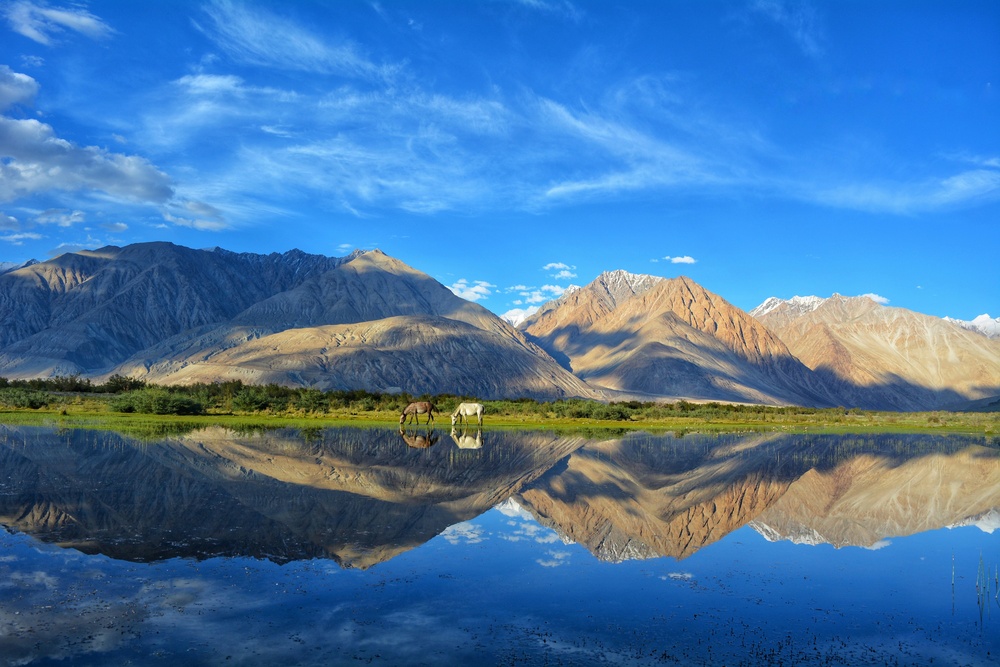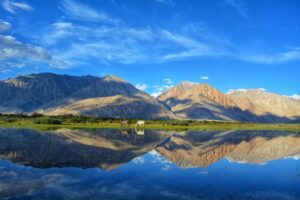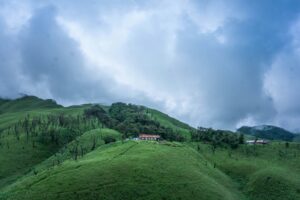
Ladakh Tourism offers travellers a journey into a world of surreal landscapes, ancient monasteries, high mountain passes, turquoise lakes, and vibrant Tibetan-Buddhist culture. Popularly known as the “Land of High Passes,” Ladakh, located in the northernmost part of India, is a dream destination for bikers, adventure seekers, spiritual travellers, photographers, and nature lovers alike. From the majestic Pangong Lake to the serene monasteries perched on rugged hills, Ladakh Tourism promises an experience like no other.
Leh – The Gateway to Ladakh
Leh is the capital and the most popular base for Ladakh Tourism. At an altitude of over 11,000 feet, this historic town is famous for its bustling markets, Tibetan cafes, and monasteries. Leh Palace, built in the 17th century, resembles Lhasa’s Potala Palace and offers panoramic views of Leh town and surrounding mountains. Shanti Stupa, a white-domed Buddhist monument, is another must-visit, especially during sunset when the golden hues light up the entire Leh valley.
Leh’s Main Bazaar is ideal for buying traditional Ladakhi handicrafts, prayer flags, pashmina shawls, and silver jewellery, giving travellers a glimpse of local art and culture.
Pangong Lake – The Jewel of Ladakh Tourism
No Ladakh Tourism experience is complete without visiting Pangong Tso, the breathtaking high-altitude lake situated at 14,270 feet. The lake stretches from India to Tibet, with about 60% of it in China. Its mesmerising blue waters change colour with the sky, creating an ethereal landscape that attracts photographers and filmmakers. Camping by Pangong Lake under star-studded skies is an unforgettable experience, with the Milky Way visible in its full glory.
Nubra Valley – The Desert in the Sky
Another highlight of Ladakh Tourism is Nubra Valley, accessible via Khardung La Pass, one of the world’s highest motorable roads at 18,380 feet. Nubra Valley is famous for its cold desert landscape, sand dunes, and unique double-humped Bactrian camels found in Hunder village. Diskit Monastery, the largest in Nubra Valley, is known for its giant Maitreya Buddha statue overlooking the valley, offering spiritual peace and panoramic views.
Khardung La Pass – Gateway to Adventure
Khardung La is a major attraction for bikers and adventure enthusiasts exploring Ladakh Tourism. Riding or driving through this high mountain pass is thrilling, with prayer flags fluttering along the rugged roads and snow peaks surrounding the route. It serves as the gateway to Nubra and Shyok valleys and remains a bucket-list destination for travellers across the globe.
Tso Moriri – The Lesser-Known Alpine Lake
Tso Moriri, located in the Changthang region at an altitude of 15,000 feet, is one of the most serene Ladakh Tourism destinations. This lake is surrounded by barren hills and snow-capped peaks, creating a dramatic landscape. The Korzok Monastery nearby is the spiritual centre for the Changpa nomads, who herd pashmina goats in this region. Unlike Pangong, Tso Moriri is less crowded, offering tranquillity and a chance to witness rare migratory birds like the black-necked crane.
Monasteries of Ladakh – Centres of Culture and Spirituality
Monasteries form the cultural heart of Ladakh Tourism. Hemis Monastery, the largest and wealthiest monastery in Ladakh, is known for its annual Hemis festival celebrating Guru Padmasambhava’s birth with masked dances and vibrant rituals. Thiksey Monastery, resembling Tibet’s Potala Palace, houses a 49-feet tall statue of Maitreya Buddha and offers panoramic views of Indus Valley.
Other notable monasteries include Alchi, famous for its 11th-century wall paintings; Lamayuru, known as the ‘Moonland’ for its lunar-like landscapes; and Diskit Monastery in Nubra Valley. These monasteries are not just religious centres but also guardians of Ladakh’s ancient art, culture, and traditions.
Adventure Tourism in Ladakh
Ladakh Tourism is a haven for adventure lovers. Popular activities include:
- Trekking: The Markha Valley trek and Chadar Trek (walking over the frozen Zanskar river in winter) are thrilling experiences attracting trekkers globally.
- River Rafting: Indus and Zanskar rivers offer white-water rafting amidst dramatic gorges and cliffs.
- Motorbiking: Riding from Manali to Leh or Srinagar to Leh is among the world’s most sought-after biking routes, with challenging terrains and breathtaking landscapes.
Festivals of Ladakh
Ladakh Tourism is incomplete without experiencing its vibrant festivals. The Ladakh Festival in September showcases folk dances, polo matches, archery, and handicrafts, celebrating the region’s cultural heritage. The Hemis Festival, held at Hemis Monastery in June-July, features sacred masked dances and rituals, attracting both tourists and locals in colourful traditional attire.
Best Time to Visit Ladakh
The best time to explore Ladakh Tourism is from May to September when the weather is pleasant, and mountain passes are open for travel. Winters (October to March) are harsh with temperatures dropping below -20°C, but ideal for experiencing frozen landscapes and the Chadar Trek for experienced trekkers.
Responsible Tourism in Ladakh
Due to its fragile ecosystem, Ladakh Tourism promotes responsible travel. Travellers are encouraged to avoid plastic waste, respect local customs, conserve water, and maintain ecological balance while enjoying Ladakh’s pristine beauty.
Conclusion
Ladakh Tourism is a journey into a surreal Himalayan wonderland that combines natural beauty, spiritual depth, adventure, and cultural richness. From shimmering lakes and ancient monasteries to desert valleys and thrilling mountain passes, Ladakh offers experiences that remain etched in your memory forever. Plan your next escape to Ladakh and immerse yourself in the raw, untouched, and enchanting landscapes of the Land of High Passes.






